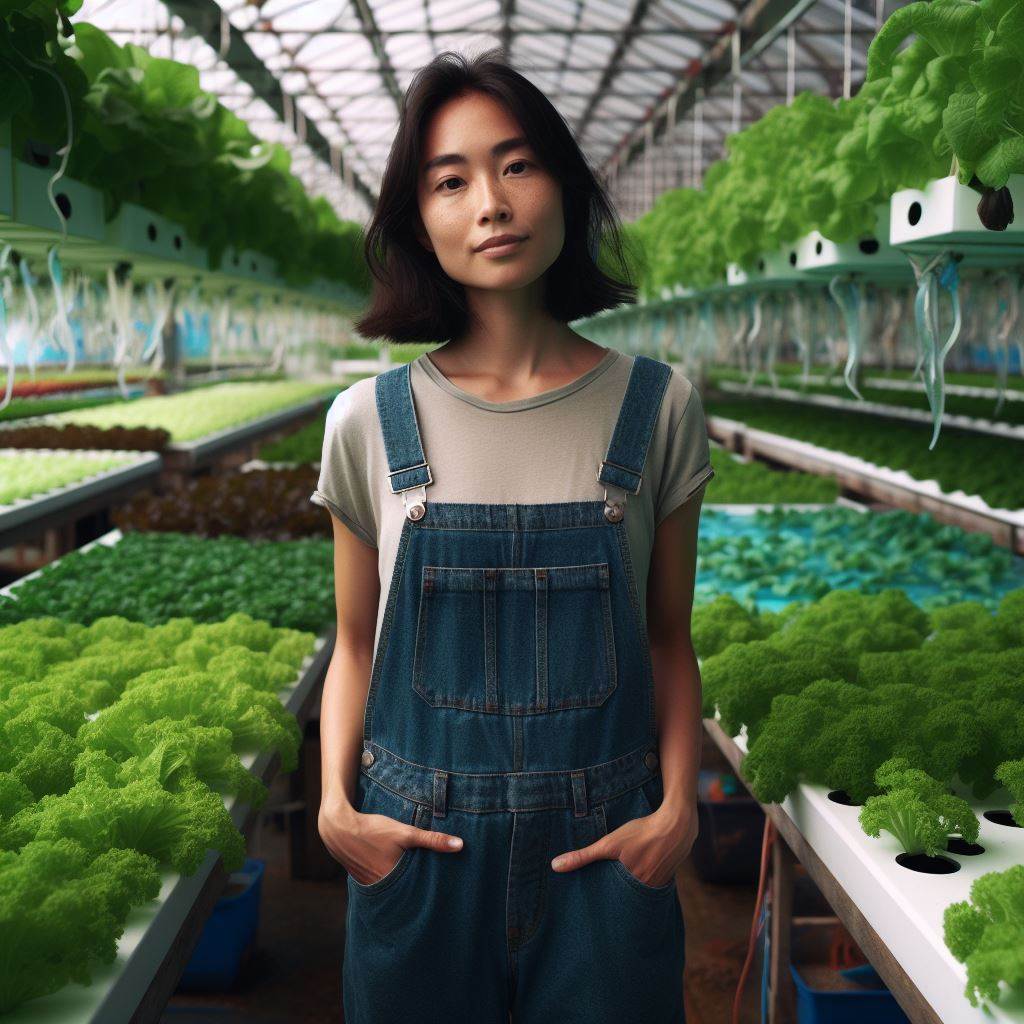Introduction
Aquaponics is a sustainable farming method that combines aquaculture and hydroponics in a unique way.
It involves the cultivation of fish and plants together in a symbiotic relationship.
By utilizing waste produced by the fish, the plants are able to obtain essential nutrients.
This system eliminates the need for chemical fertilizers and pesticides, promoting organic farming practices.
Aquaponics allows for the efficient use of water, as it is recirculated within the system.
Compared to traditional farming methods, aquaponics uses 90% less water.
The fish in the system also benefit from the clean and filtered water, resulting in healthier and faster growth.
This method is gaining popularity due to its numerous benefits, including high crop yields and reduced environmental impact.
Sustainable farming methods like aquaponics play a crucial role in ensuring food security for the future.
With increasing population and limited resources, it is important to adopt innovative and eco-friendly farming techniques.
Aquaponics not only provides a solution to the challenges faced by traditional farming but also promotes sustainable agriculture.
This farming method has the potential to revolutionize the way we grow food, making it a viable option for the future.
As we strive to create a more sustainable and resilient food system, aquaponics offers a promising solution.
In the next section, we will explore the various components and functioning of an aquaponics system in detail.
What is Aquaponics?
Definition and explanation of aquaponics
Aquaponics is a sustainable farming system that combines aquaculture and hydroponics to create a symbiotic relationship between fish and plants.
Transform Your Agribusiness
Unlock your farm's potential with expert advice tailored to your needs. Get actionable steps that drive real results.
Get StartedHow it combines aquaculture and hydroponics
Aquaculture involves raising fish in tanks or ponds, while hydroponics is a method of growing plants without soil.
In aquaponics, the waste produced by the fish is converted into nutrients for the plants.
The plants, in turn, filter and purify the water, creating a clean environment for the fish.
This closed-loop system is highly efficient and requires less water and space compared to traditional farming methods.
Aquaponics is a great solution for areas with limited access to fertile land or water resources.
It also eliminates the need for chemical fertilizers and pesticides, making it environmentally friendly.
Benefits of Aquaponics
One of the key benefits of aquaponics is the ability to produce both fish and vegetables simultaneously.
This dual purpose maximizes the productivity and profitability of the system.
Moreover, the fish and plants grown in aquaponics are organic and free from harmful substances.
Aquaponics also eliminates the risk of water pollution, as the water is continuously recycled within the system.
The water is constantly monitored and adjusted to maintain optimal conditions for the fish and plants.
This ensures consistent growth and a high yield of both fish and crops.
Another advantage of aquaponics is its versatility and scalability.
It can be implemented on a small scale in backyard gardens or on a larger scale in commercial farms.
The system can be customized to accommodate different varieties of fish and plants.
It also allows for year-round production, regardless of the climate or season.
In addition to food production, aquaponics has other potential applications.
It can be used in educational settings to teach students about sustainable agriculture.
Additional benefits
Aquaponics can also be used in urban areas to grow fresh produce locally and reduce transportation costs.
The system is low-maintenance and can be automated, making it accessible to people with limited farming experience.
By utilizing technology, aquaponics has the potential to revolutionize the future of farming.
In short, aquaponics is a sustainable farming method that combines aquaculture and hydroponics.
It is environmentally friendly, efficient, and highly productive.
The symbiotic relationship between fish and plants in aquaponics creates a closed-loop system that is both economical and sustainable.
Showcase Your Farming Business
Publish your professional farming services profile on our blog for a one-time fee of $200 and reach a dedicated audience of farmers and agribusiness owners.
Publish Your ProfileWith its versatility and scalability, aquaponics has the potential to play a significant role in future farming practices.
Read: Eco-Friendly Farming: Aquaponics Insights
Benefits of Aquaponics
Aquaponics is an innovative farming method that combines aquaculture and hydroponics, offering numerous benefits over traditional farming techniques.
Increased Productivity
One of the significant advantages of aquaponics is its increased productivity compared to conventional farming methods.
By creating a symbiotic relationship between fish and plants, it allows for the simultaneous growth of both.
This cultivation technique ensures a constant supply of nutrients for plants, resulting in faster and larger crop yields.
Farmers can harvest up to four times more produce in the same area compared to traditional soil-based farming.
Efficient Use of Resources
Aquaponics is highly resource-efficient as it maximizes the use of water, energy, and space.
Unlike traditional farming, which requires vast amounts of water, aquaponics reuses and recirculates water in a closed system.
By utilizing the fish waste as a nutrient source for plants, the water consumption is significantly reduced.
This water-saving feature is particularly vital in regions facing water scarcity and drought conditions.
Additionally, aquaponics also utilizes energy more efficiently by relying on natural processes and minimizing the need for mechanized irrigation systems.
Moreover, aquaponic systems are well-suited for urban environments, as they can be built vertically and occupy limited space.
This efficient use of space allows farmers to grow crops in areas where traditional soil-based farming is impractical.
Elimination of Chemical Fertilizers and Pesticides
Aquaponics eliminates the need for chemical fertilizers and pesticides, making it an environmentally-friendly farming method.
The fish waste provides a natural nutrient source for plants, eliminating the need for synthetic fertilizers.
With the elimination of fertilizers and pesticides, aquaponics promotes organic farming practices and reduces the risk of soil and water contamination.
This eliminates potential health risks for both farmers and consumers.
Reduced Water Consumption and Waste Production
Due to its closed-loop system, aquaponics significantly reduces water consumption compared to conventional farming.
The water is constantly recycled, requiring only occasional top-ups to compensate for evaporation.
Furthermore, aquaponics minimizes waste production.
In traditional farming, excess nutrients and chemicals leach into the environment, causing pollution.
However, in aquaponics, fish waste is efficiently utilized by plants as nutrients, leaving little to no waste materials.
Potential for Year-Round Cultivation
Aquaponics provides the potential for year-round cultivation, regardless of the climate or season.
By controlling the environmental conditions, farmers can create an optimal growth environment for the plants.
The combination of hydroponics and aquaculture allows farmers to grow crops throughout the year without being limited by external factors such as temperature, weather conditions, or pests.
This ensures a steady and continuous food supply, reducing dependence on seasonal harvests.
Generally, aquaponics offers numerous benefits over traditional farming methods – increased productivity, efficient resource use, elimination of chemical inputs, reduced water consumption and waste production, and potential for year-round cultivation.
With its sustainable and innovative approach, aquaponics has the potential to revolutionize the future of farming.
Read: Indoor Eden: Hydroponic Systems for Home
Environmental Sustainability
Aquaponics, as a method of farming, offers multiple benefits to the environment.
This innovative technique, which combines aquaculture and hydroponics, has gained popularity in recent years.
Reduction in negative environmental impacts
One of the significant advantages of aquaponics is the reduction in negative environmental impacts.
Compared to conventional farming methods, aquaponics requires less water, energy, and space.
By utilizing a closed-loop system, water is continuously recycled, minimizing wastage and reducing the strain on freshwater resources.
Additionally, the use of chemical fertilizers and pesticides is significantly reduced, preventing water pollution and soil degradation.
Preservation of natural resources
Moreover, aquaponics also contributes to the preservation of natural resources.
Traditional farming often involves extensive land use, leading to deforestation and habitat destruction.
In contrast, aquaponic systems can be set up in urban areas, utilizing vertical and indoor farming techniques.
This allows for the conservation of valuable land resources and the protection of natural ecosystems.
Showcase Your Farming Business
Publish your professional farming services profile on our blog for a one-time fee of $200 and reach a dedicated audience of farmers and agribusiness owners.
Publish Your ProfileProtection of biodiversity and ecosystem health
Aquaponics also plays a crucial role in the protection of biodiversity and ecosystem health.
The controlled environment of aquaponic systems helps prevent the introduction of invasive species, which can pose a threat to native flora and fauna.
By eliminating the need for harmful chemicals, such as pesticides and antibiotics, aquaponics supports a healthier and more balanced ecosystem.
Moreover, the integration of fish and plants in an aquaponic system creates a symbiotic relationship that mimics natural ecological processes.
Fish waste provides essential nutrients for plant growth, while plants act as a natural filter, cleansing the water for the fish.
This balance helps maintain a stable ecosystem, reducing the risk of diseases and promoting overall ecosystem health.
Essentially, aquaponics offers numerous environmental benefits, contributing to a more sustainable future.
By reducing negative environmental impacts, preserving natural resources, and protecting biodiversity, this innovative farming method offers a solution to many of the challenges faced by conventional agriculture.
Read: Fish-Powered Gardens: Aquaponics Guide
Economic Advantages
Lower production costs
Aquaponics offers several economic advantages that make it an attractive option for farmers and entrepreneurs alike.
One of the main benefits is the lower production costs compared to traditional farming methods.
With aquaponics, the use of fertilizers and pesticides is minimized or even eliminated, leading to reduced expenses for inputs.
Additionally, the closed-loop system eliminates the need for extensive water usage, resulting in lower water bills.
These cost savings can significantly impact the profitability of the operation.
Potential for increased profitability
Apart from lower costs, aquaponics also has the potential for increased profitability.
By combining fish farming with plant cultivation, farmers can tap into multiple revenue streams.
The produce from the plant beds, such as lettuce or herbs, can be sold directly to consumers or restaurants, generating additional income.
The fish, on the other hand, can be sold as a premium product, commanding higher prices in the market.
Diversification of income sources
Furthermore, aquaponics allows for the diversification of income sources.
Traditional farmers often face risks associated with relying solely on one type of crop, which can be susceptible to disease, pests, or changing market demands.
By implementing aquaponics, farmers can mitigate these risks by simultaneously producing both fish and crops.
This diversification ensures a more stable and resilient income, with the ability to adjust production levels according to market demand.
Job opportunities in aquaponics industry
The rise of aquaponics also opens up job opportunities in the industry.
As this form of farming gains popularity, there is an increasing need for skilled workers in aquaponic system design, installation, and maintenance.
Additionally, entrepreneurs can establish specialized aquaponics consulting firms or provide training to farmers interested in adopting this innovative farming method.
These job opportunities contribute to the growth and development of the aquaponics industry, creating a positive economic impact.
In general, the economic advantages of aquaponics make it a promising option for farmers and entrepreneurs.
Lower production costs, increased profitability through diverse revenue streams, and job opportunities in the aquaponics industry are all factors that contribute to its appeal.
With the potential to revolutionize the agricultural sector, aquaponics presents an exciting future for farming and sustainable food production.
Read: Hydroponics vs. Soil: What’s Best for You?

Challenges and Limitations
Initial setup costs and maintenance
Aquaponics systems require an initial investment that can be costly, including tanks, pumps, and grow beds.
Ongoing maintenance is necessary to ensure the health of the fish, plants, and overall system.
Proper water filtration, nutrient balance, and regular monitoring are essential for successful aquaponics.
Expertise and knowledge required
Aquaponics demands specialized knowledge and expertise in fish and plant cultivation.
Understanding the symbiotic relationship between fish waste, bacteria, and plant growth is crucial.
Farmers must have a solid grasp of water quality, pH levels, nutrient requirements, and pest management.
Dependence on electricity and technology
Aquaponics heavily relies on electricity to power pumps, filters, and other necessary components.
Without a stable electricity supply, the entire system may collapse, endangering the fish and plants.
Furthermore, technological failures can disrupt the aquaponics system, leading to devastating consequences.
Market demand and competition
While the interest in sustainable farming is growing, the market demand for aquaponics products is still developing.
Showcase Your Farming Business
Publish your professional farming services profile on our blog for a one-time fee of $200 and reach a dedicated audience of farmers and agribusiness owners.
Publish Your ProfileCompetition exists with conventional agriculture, hydroponics, and traditional aquaculture, making it difficult to carve a niche.
Farmers must differentiate themselves through quality, branding, education, and marketing to meet market demands.
In essence, aquaponics presents numerous challenges and limitations that farmers must overcome.
The initial setup costs, ongoing maintenance, and the need for expertise and knowledge can be daunting.
Furthermore, the reliance on electricity and technology adds an additional level of vulnerability.
Market demand and competition further complicate the scalability and profitability of aquaponics.
However, the potential benefits it offers in terms of sustainability, efficiency, and reduced environmental impact make it worth exploring.
With the right approach, aquaponics could revolutionize future farming.
Read: Water Works: Basics of Home Aquaponics
Future Potential and Development
Growing popularity and adoption worldwide
The global agricultural landscape is seeing the rise of aquaponics, a system that merges aquaculture (fish farming) with hydroponics (soilless plant cultivation).
This innovative approach to food production is gaining traction worldwide for its potential to address pressing agricultural challenges, garnering interest from farmers, communities, and research institutions alike.
Technological advancements and innovative solutions
The future of aquaponics holds immense promise, fueled by continuous advancements in technology.
Cutting-edge materials and designs are being developed to optimize resource utilization and system performance, leading to increased yields and reduced environmental impact.
Imagine self-regulating systems that automatically adjust water flow, nutrient levels, and temperature based on real-time data – a future where aquaponics becomes even more efficient and sustainable.
Integration of automation and AI
Furthermore, the integration of automation and artificial intelligence (AI) promises to revolutionize aquaponic systems by streamlining monitoring, data analysis, and decision-making.
Imagine AI-powered systems that not only monitor key parameters but also predict potential issues and recommend adjustments, empowering farmers to make informed decisions for optimal crop health and fish well-being.
Collaboration between farmers, scientists, and technologists
However, unlocking the full potential of aquaponics requires fostering a collaborative spirit among key stakeholders.
Farmers, armed with practical expertise, can provide valuable insights into real-world challenges and opportunities.
Scientists, leveraging their research prowess, can contribute to system optimization, problem-solving, and developing new plant and fish varieties specifically suited for aquaponic environments.
Technologists, wielding the power of innovation, can develop novel solutions and tools like advanced sensors, data-driven platforms, and automated systems.
This collaborative effort, uniting diverse capabilities, can pave the way for a more sustainable and secure food future where aquaponics plays a central role.
Conclusion
Aquaponics offers numerous advantages and incredible potential for future farming.
It combines the benefits of aquaculture and hydroponics, providing a sustainable and efficient method of food production.
By using less water, land, and energy, aquaponics can help mitigate the environmental impact of traditional agriculture.
As discussed earlier, aquaponics can produce both fish and plants simultaneously, increasing productivity and profitability.
Moreover, the symbiotic relationship between the fish and plants creates a closed-loop system, eliminating the need for chemical fertilizers or pesticides.
Farmers should consider exploring aquaponics as a viable alternative to traditional farming methods.
It offers a more stable and resilient system that is less prone to climate change and weather fluctuations.
Additionally, aquaponics can be practiced in urban areas, reducing the distance between farms and consumers, thus promoting local food production.
Supporting sustainable farming practices, such as aquaponics, is crucial for the future of food production.
The world’s population is continually growing, and the current farming practices cannot sustainably meet the increasing demand for food.
By adopting innovative and sustainable methods like aquaponics, we can ensure food security, conserve natural resources, and reduce the negative impacts on the environment.
In a nutshell, aquaponics presents a promising solution for future farming.
It is a holistic approach that integrates aquaculture and hydroponics, providing numerous advantages in terms of productivity, resource efficiency, and environmental sustainability.
As we strive to feed a growing population, it is essential for farmers and policymakers to support and invest in the development and adoption of these sustainable farming practices.
Together, we can shape a brighter and more sustainable future for agriculture.




